Subphylum Crustacea (Crustaceans) — Order Decapoda
Crabs — Family Cancridae (Cancer Crabs)
Genus Cancer
••••••••••••••••••••••••••••• Dungeness Crab ••••••••••••••••••••••••••••••
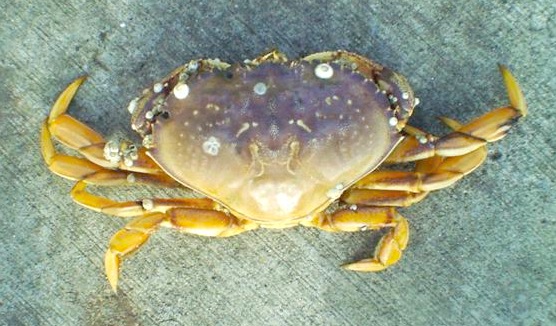 A Dungeness from the Pacifica Pier
A Dungeness from the Pacifica Pier
Species: Cancer magister (Dana, 1852). Some scientists, based on the shapes of the teeth of the carapace, have called for a new genus name Metacarcinus which would mean a scientific name of Matacarcinus magister. Until clarified we will use the traditional classification.
Alternate Name: Market crab. Its common name comes from the town once called Dungeness in Washington (today it’s called Old Town). A common name by anglers: Dungie.
Identification: Dungeness crabs have a wide, long, hard carapace (shell), and five pairs of legs. Unlike most of their cousins, Dungeness have white-tipped pincers on the claws (chelipeds). The top edges of the claws, and the upper pincers have sawtooth-like serrations that contain more than a dozen teeth along each edge. The crabs use these claws for defense and to rip apart their food. They use their smaller appendages to pass the food particles into its mouth. Once inside the crab’s stomach, food is further digested by a collection of tooth-like structures called the “gastric mill.” The last three joints of the last pair of walking legs have a comb-like fringe of hair on the lower edge, and the joint previous to these has hair on both top and bottom edges, but with a much greater amount on the top edge. In both male and female, the tip of the last segment of the tail flap is rounded (unlike other crabs in this group). The color of the Dungeness is generally light reddish brown to gray on the back (often with light streaks and spots), with a purplish wash anteriorly; the underside is whitish to light orange, the inner and upper sides of the anterior legs with crimson or purple.
Photo ID courtesy of the Oregon Department of Fish and Wildlife
Size: To 9.8 inches across the back for males (most less than 8 inches), females to 6.5 inches.
Range: Bahía Magdelena, Baja California, to Unalaska, Alaska in the Aleutian Islands (some sources say to the Pribilof Islands in Alaska). In California, adults are rarely seen south of Point Conception; most common from Monterey Bay north. As a general rule, the farther north you go the better your chance for netting crabs.
Habitat: Recorded from intertidal depths down to 750 feet but are most common on sandy and mud bottoms from 60 to 300 feet deep. Inhabits eelgrass beds in bays. Estuaries are important to their life cycle and they inhabit all such areas between Morro Bay and Puget Sound, Washington. Dungeness are scavengers that will almost anything; their preferences are clams, other crustaceans and small fish.
Piers: Most commonly found on piers that sit over a sand or mud bottom. Most pier-caught Dungeness are taken on piers from Pacifica north. Many rivers along the north coast see an influx of Dungeness into their estuary areas during late winter and early spring months, and harbors and bays are active spawning grounds for Dungeness. In these far northern waters Dungeness are common and at times a nuisance (if you’re an angler concentrating on fish). On one of my trips to Eureka nearly every cast saw a crab latch on to the bait. I finally had to switch to artificial lures to keep the crabs off my line. Of course if I had been crabbing (which I wasn’t) I would have had no complaints. Best piers seem to be the Pacifica Pier, Lawson’s Landing Pier (Tomales Bay), almost any pier in Humboldt Bay, and either of the two piers at Crescent City. Although a common catch at piers inside San Francisco Bay, and even into San Pablo Bay, it is illegal to keep Dungeness in these bays.
 Dungeness crabs at the Pacifica Pier
Dungeness crabs at the Pacifica Pier
Shoreline: Almost all sandy-shore beaches north of Half Moon Bay will see Dungeness, as will areas inside of bays from Tomales Bay north.
Boats: An important goal for boaters from Half Moon Bay north. As regulations have changed and made it more difficult to keep some species, i.e., rockfish, many Sportfishing boats in central and northern California have begun to run combination fish and crab trips.
Bait and Tackle: Traditionally taken with hoop nets but more and more people use crab snares each year.
 A crab snare at the Pacifica Pier
A crab snare at the Pacifica Pier
 Snares ready to go at Pacifica
Snares ready to go at Pacifica
 A Dungeness caught on a snare at Pacifica
A Dungeness caught on a snare at Pacifica
Food Value: About one-quarter of the weight of a Dungeness is meat with the bigger the crab the larger the percentage of meat. The flesh has what is considered to be a delicate flavor that is slightly sweet. Live crabs are cooked by dropping them into boiling salt water, waiting for the boil to return, and then cooking for another 15 minutes. The crabs are then placed into cold water and cleaned. Two common tools for removing crabmeat from the shell are a crab cracker and a shrimp fork. Sometimes, a cleaver, mallet or small hammer is used for cracking.
 A crab net (hoop net) at Pacifica
A crab net (hoop net) at Pacifica
Comments: Generally considered the most desirable of California crabs. It is also known as the market crab and is familiar to anyone who has visited San Francisco’s Fisherman’s Wharf. The crab reaches a good size, yields more meat per crab than most other species, and the meat is firm and delicious.
 A Dungeness from the B Street Pier in Crescent City
A Dungeness from the B Street Pier in Crescent City
 A Dungeness taken by illcatchanything (Brian Linebarger) at the Fort Baker Pier. Since Dungeness are illegal in San Francisco Bay (all waters inside the Golden Gate), this “Dungie” was returned to the water to grow and perhaps be caught another day.
A Dungeness taken by illcatchanything (Brian Linebarger) at the Fort Baker Pier. Since Dungeness are illegal in San Francisco Bay (all waters inside the Golden Gate), this “Dungie” was returned to the water to grow and perhaps be caught another day.
 Crab net and smallish-sized Dungeness from the B Street Pier in Crescent City
Crab net and smallish-sized Dungeness from the B Street Pier in Crescent City
••••••••••••••••••••• Slender Crab or Graceful Crab ••••••••••••••••••••••••
 Species: Cancer gracilis (Dana, 1852). (Alternate Metacarcinus gracilis)
Species: Cancer gracilis (Dana, 1852). (Alternate Metacarcinus gracilis)
Alternate Name: Graceful rock crab.
Identification: The slender crab has a very broad and oval-shaped shell with dull tooth-like protrusions toward the front of the shell and slender walking legs. They, and Dungeness crabs, are the only two members of this group of crabs whose chelae (claws) are white tipped. The tops of the claws are sharp-edged, with two or three prominent teeth, but these edges are not the saw tooth-like serrations seen in Dungeness. Female crabs can be distinguished from males by the broad tail flap on their undersides, which are used for protecting their eggs when they are gravid. Due to their relatively small size, slender crabs are frequently mistaken for juvenile Dungeness crabs. They can be distinguished from Dungeness by their (almost always) hairless legs; Dungeness have hair on the posterior three legs. In addition, in the slender crab the last segment of its tail flap is pointed, where that of Dungeness is curved. The slender crab usually has a shell that is olive brown and legs that vary from yellowish brown to purple. The underside is white or yellowish white.
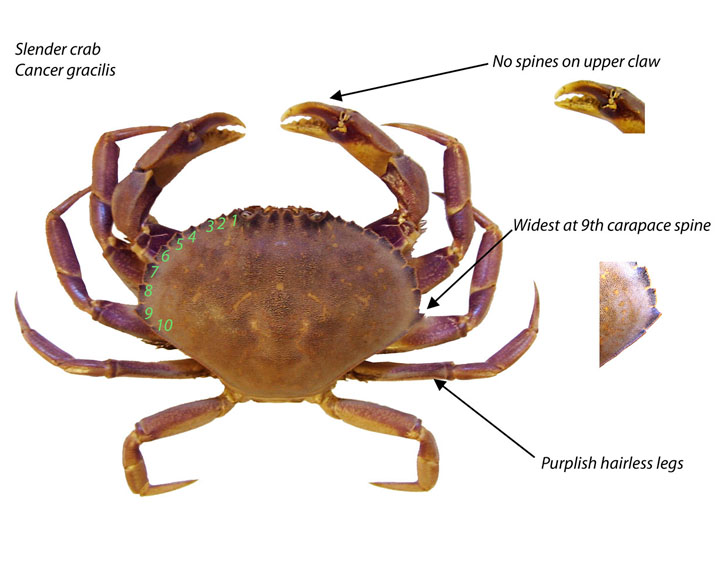 Photo ID courtesy of the Oregon Department of Fish and Wildlife
Photo ID courtesy of the Oregon Department of Fish and Wildlife
Size: Small, males to 4.5 inches across the back, females to 3.4 inches.
Range: Bahía Playa Maria, Baja California, to Prince William Sound, Alaska. Most commonly seen in central California.
Habitat: Recorded from intertidal depths down to 570 feet but primarily found in shallow inshore environments—sandy and muddy bottoms, eelgrass beds and kelp beds. They do not tolerate low salinity brackish environments as well as some species and are usually not found in estuaries (although seasonally found in sloughs and bays).
Piers: Occasionally taken from piers, especially those between Avila and Sonoma County.
Shoreline: Occasionally taken by people seeking out Dungeness and often mistakenly discarded as undersized Dungeness.
Boats: Rarely taken from boats.
Bait and Tackle: Hoop nets and crab snares.
Food Value: Although taken by recreational anglers they are generally small and do not yield an abundance of meat.
Comments: Due to their fairly small size it’s best just to release them.
•••••••••••••••••••••• Yellow Crab or Yellow Rock Crab •••••••••••••••••••••
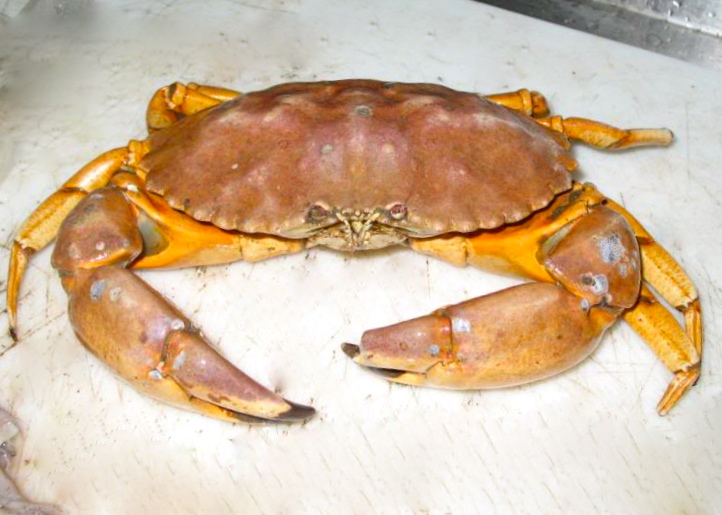 A yellow crab taken from the Santa Monica Pier by Mahigeer (Hashem Nahid)
A yellow crab taken from the Santa Monica Pier by Mahigeer (Hashem Nahid)
Species: Cancer anthonyi, (Rathbun, 1897). (Alternate Metacarcinus anthonyi). The name honors Alfred Webster Anthony, a naturalist working in San Diego.
Alternate Names: Yellow crab and yellow rock crab.
Identification: Yellow crabs have an oval-shaped, fairly broad and hard shell. Yellow crabs are noted for large black-tipped pincers on the claws with the claws large and smooth resembling those of rock crabs. However, they can be distinguished from rock crabs by their lack of red spotting on the underside. Coloring is yellow or yellowish-brown above with a purple wash anteriorly and on the legs (some specimens). The underneath is plain yellow or yellowish-white. The juvenile crabs tend to be darker than the adults.
 A big yellow crab from the Hermosa Beach Pier
A big yellow crab from the Hermosa Beach Pier
Size: Males to 6.9 inches across the back, females to 5.6 inches.
Range: Bahía Magdelena, Baja California, to Humboldt Bay in Northern California, but uncommon north of Point Conception.
Habitat: Recorded from intertidal depths down to 430 feet but primarily found on sandy habitat between 60 to 180 feet. In the north, where many of the benthic areas are rocky, they are more commonly found in bays, sloughs and estuaries.
Piers: Not really a common species from piers since they tend to be caught in deeper waters. Nevertheless, they are the main “rock crabs” taken from SoCal piers. Best bets: Santa Monica Pier and Stearns Wharf in Santa Barbara.
Shoreline: Few adult yellow crabs are caught in shallow, inshore waters.
Boats: A moderate goal of southern California boaters.
Bait and Tackle: Hoop nets and crab snares.
Food Value: Excellent. Most food is found in the claws and legs but its delicate and sweet.
Yellow crabs taken from the Santa Monica Pier by Mahigeer (Hashem Nahid)
Comments: Yellow crabs are the most abundant crab landed in southern California, 70-95% of the total commercial crab catch.
 Yellow crabs taken from the Paradise Cove Pier by Mahigeer (Hashem Nahid)
Yellow crabs taken from the Paradise Cove Pier by Mahigeer (Hashem Nahid)
•••••••••••••••••••••• Red Crab or Red Rock Crab ••••••••••••••••••••••••
 A red crab from Stearns Wharf in Santa Barbara
A red crab from Stearns Wharf in Santa Barbara
Species: Cancer productus (Randall, 1839).
Alternate Names: Red crab or red rock crab.
Identification: Red crabs have a wide, hard shell with large, black-tipped pincers on the claws. The hands of the claws are rough, particularly above, but not saw-toothed as in the Dungeness crab. They are identified by their large broad tail flaps (although the tip of the last segment of the tail flap is pointed in both male and female). Adult red crabs are generally brick red above with an underside that is yellowish white with orange-red blotching’s. Young crabs may show many different color patterns including white, and some show up with spots or stripes. The tail flap in the female has a great deal of red, as does the tail flap of the female rock crab. The red blotching’s on the underside of the red crab are not to be confused with the distinct red spots found on the underside of the rock crab.
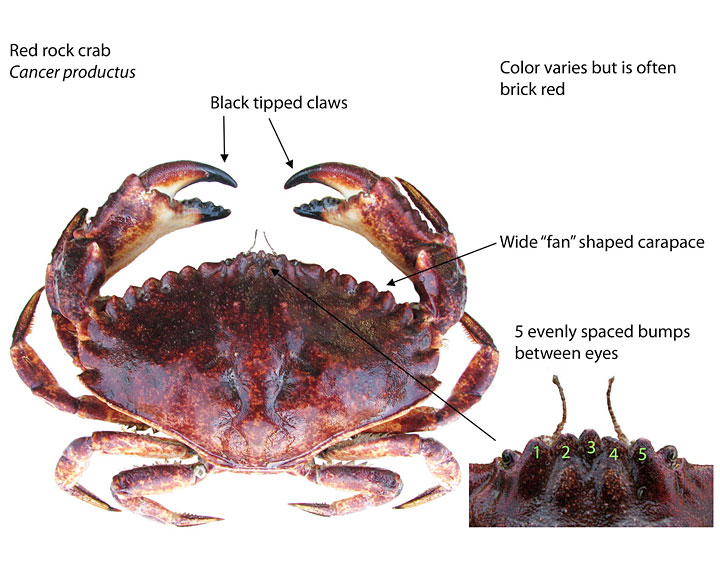 Photo ID courtesy of the Oregon Department of Fish and Wildlife
Photo ID courtesy of the Oregon Department of Fish and Wildlife
Size: Males to 7.8 inches across the back, females to 6.2 inches.
Range: Isla San Martin, Baja California to Kodiak Island, Alaska
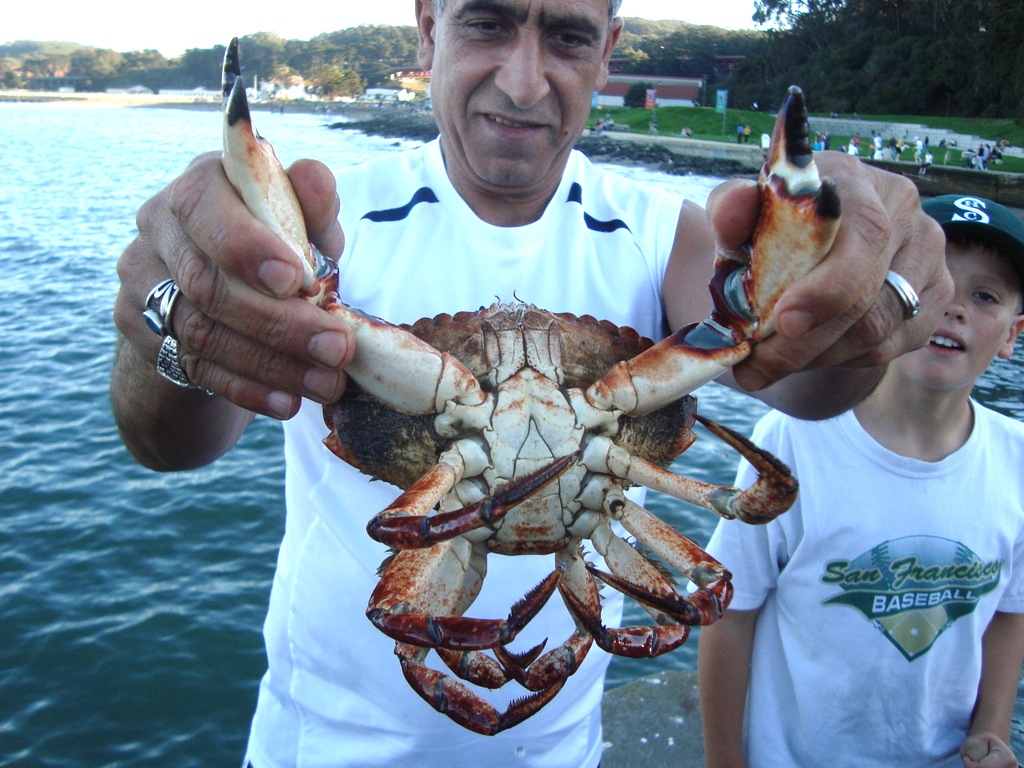 A red crab from the Fort Point Pier in San Francisco
A red crab from the Fort Point Pier in San Francisco
Habitat: Although recorded from the low intertidal zone down to a depth of 300 feet, primarily lives in shallow inshore environments on rocky substrate—rocky reefs, boulder-strewn beaches, and gravel beds (they cannot live on bottoms of mud or pure sand). They do not tolerate low salinity as well as some crabs and thus are not seen in estuaries as often as some species. Red crabs are carnivorous and will eat almost anything including barnacles, small crabs, and dead fish. Apparently one of their favorite foods are green crabs, which is good since green crabs are an invasive species that should be eliminated. Rarely are the two species found in the same estuary habitats.
 Red crab from the Trinidad Pier
Red crab from the Trinidad Pier
Piers: Found at piers located in rocky areas, primarily those from Santa Barbara north. A considerable number of these crabs are taken at rocky-area piers in San Francisco Bay, Tomales Bay, Bodega Bay, and Humboldt Bay. They are taken at Trinidad Pier north of Eureka and around Citizen’s Dock in Crescent City; they are the main “rock crabs” taken in northern California. Although it would seem to be a natural area, I have seen few of these caught at the Point Arena Pier.
Shoreline: A commonly encountered crab while fishing in rocky areas of the central and northern coast but rarely sought out by anglers due to the difficulty of using crab hoops and snares in such areas.
Boats: Available to boaters in rocky areas but generally they take a backseat to those seeking out Dungeness crabs.
 Red crab (although possibly a rock crab) from the Elephant Rock Pier in Tiburon
Red crab (although possibly a rock crab) from the Elephant Rock Pier in Tiburon
Bait and Tackle: Hoop nets and crab snares.
Food Value: Although sport fishermen are able to catch large numbers of these crabs, commercial fishermen land few. Red crabs yield a lower amount of flesh than Dungeness (almost all is found in the claws and legs) but the meat has a slightly sweet, delicate flavor that is delicious.
Comments: Together with rock crabs they make up the majority of crabs caught by sportsmen. Red crabs are larger but less numerous than rock crabs.
 Red crab from Lawson’s Landing in Marin County
Red crab from Lawson’s Landing in Marin County
 Even dogs are interested in crabs! Red crab from Lawson’s Landing
Even dogs are interested in crabs! Red crab from Lawson’s Landing
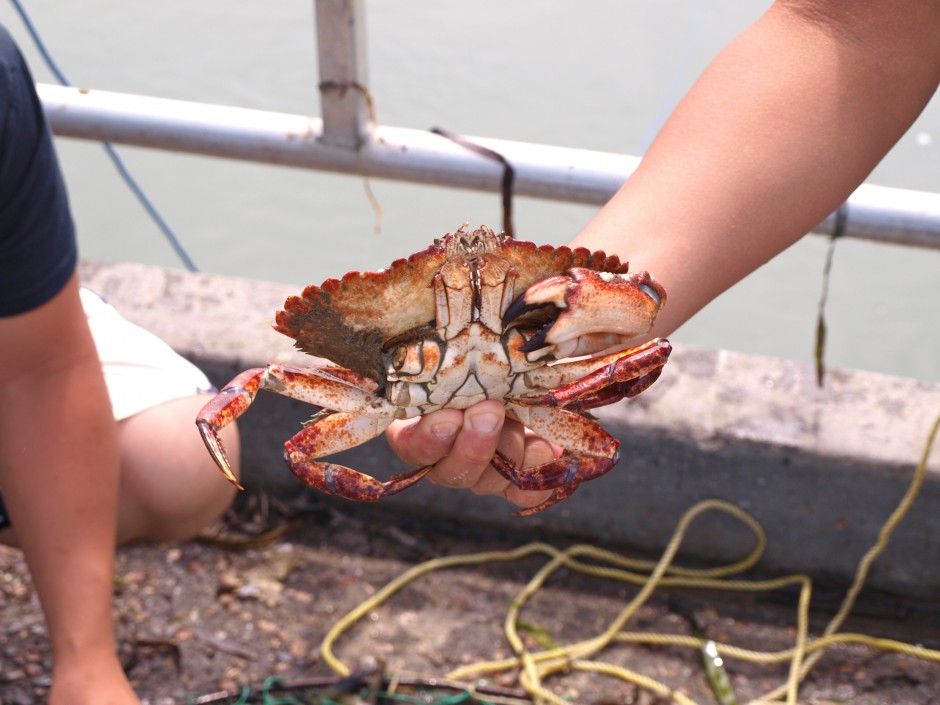 Red crab from the Del Norte Street Pier in Eureka
Red crab from the Del Norte Street Pier in Eureka
Genus Romaleon
••••••••••••• Rock Crab, Brown Rock Crab or Pacific Rock Crab ••••••••••••••
Species: Cancer antennarium (Stimpson, 1856). (Alternate proposed name Romaleon antennarium). Antennarium — Latin for “antennae” in reference to the large antennae, larger than those of other species in the family.
Alternate Names: Pacific rock crab, California rock crab, brown rock crab or just plain rock crab.
Identification: Rock crabs have a wide, hard shell with black-tipped pincers on claws that are large and smooth. Legs are “hairy” and they have distinctive long antennae between the eyestalks that are the longest of the various species. The tip of the last segment of the tail flap is pointed in both male and female. The coloring is generally medium to dark red-brown or orange, usually mottled with a lighter grayish tinge. The undersides are yellowish white with a number of small distinct red spots that help distinguish this species since they are not seen on the other species. In the female, the red spots on the tail flap are usually blocked out by a general red coloration, but the spots can be found on the legs and the underside of the shell. Red crabs have red blotching’s on the underside but not the distinct spots seen in rock crabs.
 Photo ID courtesy of the Oregon Department of Fish and Wildlife
Photo ID courtesy of the Oregon Department of Fish and Wildlife
Size: Males to 7 inches across the back, females to 5.8 inches.
Range: Cabo San Lucas, Baja California, to Virago Sound, Queen Charlotte Islands, British Columbia. Most abundant from Mexico to the San Francisco Bay area and numerically probably the number one “rock crab” in central California..
Habitat: Although recorded from the low intertidal zone down to a depth of 330 feet, they primarily live in shallow inshore environments—on sand, mud, gravel, and rock substrata in estuarine and coastal shelf areas. Rock crabs do not tolerate brackish conditions as well as some other crabs. Rock crabs feed by means of both scavenging and predation with a large diet that consists of bivalves, snails and echinoderms, as well as other crustaceans such as hermit crabs. Sensitivity to the odor of food serves as a major means of locating food. Many of the small rock crabs seen snapping and seemingly blowing bubbles, in tidepools and around rocks, will be small members of this species.
Piers: Found at most piers from Avila north to Sonoma County. Best bets: Port San Luis Pier, Santa Cruz Wharf, Fort Point Pier, San Francisco Municipal Pier, Fort Baker Pier, Lawson’s Landing Pier, and several piers in Tomales Bay and Bodega Harbor. Although very common to piers in Morro Bay, and a long time sport for local anglers, crabs (or any other invertebrates) may no longer be taken due to the Morro Bay State Marine Recreational Management Area closure.
Shoreline: Readily available inshore but the rocky areas they typically inhabit make it hard to use both hoops and snares.
Boats: Available to boaters in rocky areas but generally they take a backseat to those seeking out Dungeness crabs.
Bait and Tackle: Hoop nets and crab snares.
Food Value: Although sport fishermen are able to catch large numbers of these crabs, commercial fishermen land few. Rock crabs yield a lower amount of flesh than Dungeness (almost all is found in the claws and legs) but the meat has a slightly sweet, delicate flavor that is delicious and favored over Dungeness by many.
Comments: Since Dungeness crabs and red crabs reach the largest size, and yield the most meat, they are the preferred species. However, rock crabs are the most numerous crab caught by pier anglers in central California. Note: the proposed species name is Romaleon not Romulan, these crabs did not come from the planet Romulus nor are they related to Vulcans.
Crabs— Superfamily Majoidea (Spider Crabs)
Family Epialtidae
Genus Loxorhynchus
••••••••••••••••••••••••••••••••• Sheep Crab ••••••••••••••••••••••••••••••
 Eric and a sheep crab (spider crab) from the Redondo Beach Pier
Eric and a sheep crab (spider crab) from the Redondo Beach Pier
Species: Loxorhynchus grandis, (Stimpson, 1857): Loxorhynchus (bent nose) grandis (large).
Alternate Name: Spider crab and California king crab.
 A sheep crab (spider crab) from the Cayucos Pier in 2007
A sheep crab (spider crab) from the Cayucos Pier in 2007
Identification: Sheep crabs have a large, hard oval-shaped carapace (shell) that tapers down to spine-like points on its bent snout. All kinds of bumps (tubercles) cover its body along with a variety of growth. As juveniles, sheep crabs camouflage themselves with barnacles, sponges, hydroids and algae; adult sheep crabs are a little more refined and often have a film of green algae on the shells. Some speculate that the name sheep crab comes from the wool-like covering of algae. The crab has eight long legs and two claws.
Size: Males to 10.7 inches or more across the back, females to 4.5 inches.
Range: Cape Thurloe, Baja California, to Cordell Bank (west of Point Reyes), Marin County, California. Sheepies are most abundant in southern California.
 Mike Katz and a sheep crab (spider crab) from Stearns Wharf, Santa Barbara
Mike Katz and a sheep crab (spider crab) from Stearns Wharf, Santa Barbara
Habitat: Recorded from the low intertidal zone down to a depth of 410 feet with favorite haunts including haunts and pier pilings. Males spend the winter months in deep water while males and females migrate to shallower water in the spring. Like most crabs, they are scavengers that feed on almost anything they can find including starfish, clams and octopus.
 A sheep crab (spider crab) taken from the Crystal Pier in San Diego in 2010
A sheep crab (spider crab) taken from the Crystal Pier in San Diego in 2010
Piers: Common to most southern California piers. Best bets: Newport Pier, Balboa Pier, Redondo Beach Pier, Santa Monica Pier, Port Hueneme Pier, Stearns Wharf, and the Santa Cruz Wharf.
Shoreline: Rarely taken by shoreline anglers.
Boats: Taken in shallow, sandy-bottom areas 30-70 feet deep in the spring and summer; deeper water 120-240 feet in the winter.
Bait and Tackle: Hoop nets.
 Spider crabs (sheep crabs) — Fort Baker Pier
Spider crabs (sheep crabs) — Fort Baker Pier
Food Value: Surprisingly delicate flavor and firm texture from the meat in both the body and the legs. However, it’s somewhat of a task to clean the heavy, thick shells of sheep crabs. Sheep crab became an important commercial species in the 1980s but when gill and trammel nets were banned in 1990, the commercial catch plummeted.
Comments: One of the earliest lessons I learned when fishing at the Newport Pier was that we don’t always catch what we think we are going to catch. Not only was this true regarding fish but also in relation to a number of other strange and unusual creatures. One of the most common catches at Newport was the ugly and often fairly large spider crabs (at least they were called that by most fisherman). Although no one, to my knowledge, actually crabbed for them with nets, most days would see a few of the long-legged beasts grab hold of bottom baits intended for fish. The majority of anglers would be perplexed with the heavy but not exactly fighting weight on their line, and then watch in disgust as the creature let go of the bait halfway up to the pier’s surface. Sometimes the crab made it up to the pier and people would rush over to see the “gnarly” looking creature (whose shell would sometimes be covered with barnacles, sponges, hydroids, algae and other growth, including anemones). I’m not sure how many people actually took them home to eat (although the large crabs are delicious), but their catch spiced up the action and provided conversation for those who had never seen the creatures before.
Sheep crab from the Balboa Pier
 Do spider crabs and stingrays hang out together (it would make an interesting bar scene in an aquatic version of Star Wars)? That unusual question arose one early summer day in 1996. I had been fishing out at the end of the Redondo Sportfishing Pier for some bonito and mackerel but unfortunately those fish were not cooperating and I eventually decided to try on the bottom. There, I soon began to catch what seemed to be a seemingly numberless assemblage of small speckled sanddab. Next to me set a guy who was crabbing and he had three buckets full of large spider crabs. On one drop to the bottom I hooked something heavy and as I pulled it up realized it must be one of the crabs. Sure enough, it was, but it wasn’t really hooked. Mr. Spider Crab had grabbed hold of a sanddab on my hook and didn’t want to let go. Following about two to three feet behind the crab was a large round stingray. Halfway to the surface of the pier the crab released its pincer-hold on the fish, and the crab, together with his companion, the stingray, drifted slowly out of sight. I had seen a similar occurrence a few years ago at the Port Hueneme Pier. Did the spider crabs and stingrays have a thing going, were the stingrays just nosy, or was a form of symbiosis taking place between these two quite different species? Unfortunately, I do not have an adequate explanation for these soul-searching questions.
Do spider crabs and stingrays hang out together (it would make an interesting bar scene in an aquatic version of Star Wars)? That unusual question arose one early summer day in 1996. I had been fishing out at the end of the Redondo Sportfishing Pier for some bonito and mackerel but unfortunately those fish were not cooperating and I eventually decided to try on the bottom. There, I soon began to catch what seemed to be a seemingly numberless assemblage of small speckled sanddab. Next to me set a guy who was crabbing and he had three buckets full of large spider crabs. On one drop to the bottom I hooked something heavy and as I pulled it up realized it must be one of the crabs. Sure enough, it was, but it wasn’t really hooked. Mr. Spider Crab had grabbed hold of a sanddab on my hook and didn’t want to let go. Following about two to three feet behind the crab was a large round stingray. Halfway to the surface of the pier the crab released its pincer-hold on the fish, and the crab, together with his companion, the stingray, drifted slowly out of sight. I had seen a similar occurrence a few years ago at the Port Hueneme Pier. Did the spider crabs and stingrays have a thing going, were the stingrays just nosy, or was a form of symbiosis taking place between these two quite different species? Unfortunately, I do not have an adequate explanation for these soul-searching questions.
 A sheep crab (spider crab) taken by Burger (Jason Stalboerge) from the Ventura Pier
A sheep crab (spider crab) taken by Burger (Jason Stalboerge) from the Ventura Pier
Genus Pugettia
•••••••••••••••••••••••••••••••• Kelp Crab •••••••••••••••••••••••••••••••••
Species: Pugettia producta, (Stimpson, 1857); Pugettia (Puget Sound) producta (product of).
Alternate Name: Shield-back crab, northern kelp crab, northern lame crab, and spider crab. Called spider crabs due to their long legs and small body although they have ten legs unlike spiders that only have eight legs.
 Kelp crab from Citizens Dock in Crescent City — dorsal (top) view
Kelp crab from Citizens Dock in Crescent City — dorsal (top) view
 Kelp crab from Citizens Dock in Crescent City — ventral (bottom) view
Kelp crab from Citizens Dock in Crescent City — ventral (bottom) view
Identification: A reason for one alternative name, shield-back crab, is that the carapace (upper shell) is shaped much like a five-pointed shield or badge (one resource describes it as like an upside down shovel) that is roughly squarish-shaped but longer than wide and with a pointed front. The entire shell is almost smooth. The legs are long, smooth and end in sharp points. Coloring depends primarily on the type of food they’ve been eating and they are primarily nocturnal vegetarians (herbivores) whose favorite food is, no surprise, kelp! Thus if eating green-colored kelp they tend to be green. If eating red-colored kelp they tend to be red. Given their diverse environments, anglers may encounter a plethora, almost kaleidoscope of colors. The dorsal (back) color can range from yellow-green to greenish-brown to brown to maroon or red. The ventral (underside) color is usually red, yellow, or reddish orange. Young crabs are brown, red, or olive green. Living among kelp, and eating kelp that helps them have the color of that kelp, provides a natural camouflage and protection against predators.
 Photo ID courtesy of the Oregon Department of Fish and Wildlife
Photo ID courtesy of the Oregon Department of Fish and Wildlife
Size: Males reach 4.3 inches across the back, females 3.5 inches across the back.
Range: Punta Asunción, Baja California Sur to Bertha Bay, Chichagof Island, Alaska.
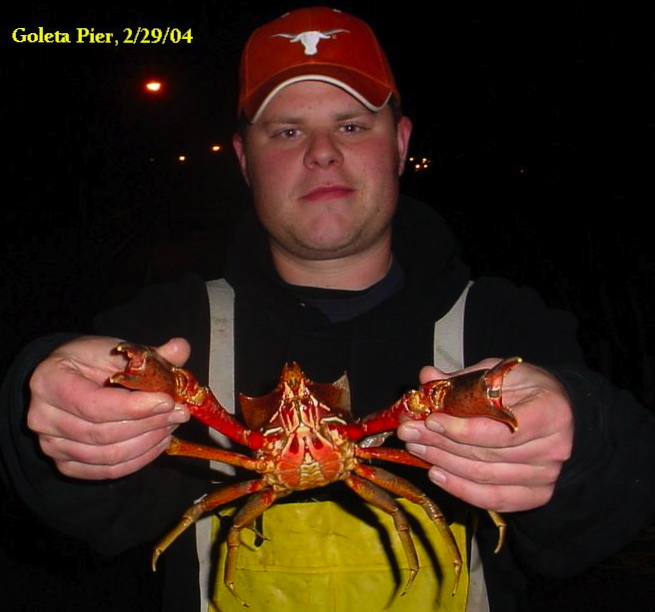 dompfabro at the Goleta Pier with a kelp crab
dompfabro at the Goleta Pier with a kelp crab
Habitat: Typically found in rocky intertidal areas, kelp beds and around structure such as pier pilings. In the fall the adults move to deeper water where they congregate, feed, and mate. Found to a depth of 240 feet. Young crabs are often in the low intertidal areas of algae and eelgrass and are sometimes found under rocks and other objects at low tide. Although kelp is their favorite food (especially bull kelp, sea cabbage and rockweed) those kelps can diminish during the winter months. At such times they will cheat on their vegetarian diets and eat such meats as barnacles, mussels, hydroids, and bryozoans. In turn, other species like to feed upon them. These include birds, other crabs, fish, octopuses, pinnipeds (seals and sea lions), and otters.
Piers: Occasionally seen at most piers from Santa Barbara north. Best bets: Stearns Wharf (Santa Barbara), Goleta Pier, Morro Bay T-Piers, Port San Luis Pier, Monterey Coast Guard Pier, San Francisco Municipal Pier, Fort Baker Pier, Point Arena Pier, Trinidad Pier, and Citizens Dock (Crescent City).
 Kelp crab from the Fort Point Pier
Kelp crab from the Fort Point Pier
Shoreline: Occasionally taken by shoreline anglers.
Boats: Occasionally taken by boaters fishing around shallow-water kelp beds.
Bait and Tackle: Taken incidentally on both fishing line and in hoop nets.
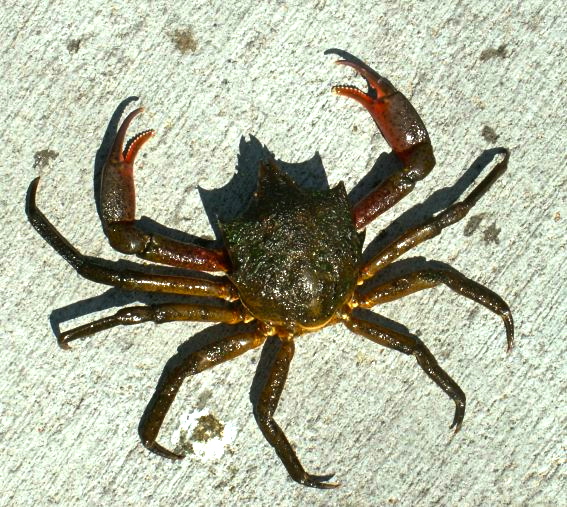 Kelp crab taken at the Balboa Pier by Daniel in 2005
Kelp crab taken at the Balboa Pier by Daniel in 2005
Food Value: Some claim the meat in the claws is both plentiful and sweet tasting.
Comments: Kelp crabs seem to be the black sheep of their family. Members of the Family Epialtida fall into a group called masking crabs (see sheep crab above) and like to attach pieces of algae, kelp, and small shells to hook-like structures on their back and legs. They use this for camouflage, masking themselves against predators. However, kelp crabs rarely do this. They are larger and relatively more active than their cousins and need to keep a clean shell for smoother movement through their intertidal environment (Ricketts et al. 1985). They will however still attach small pieces of kelp to the hook-like structures on their backs. Instead of using the kelp as a mask, they save the kelp as food to be later eaten. A note of caution: although the legs look slender and harmless, the claws are very strong and adept at both grabbing and pinching a careless victim. So, be careful!
 Kelp crab from the Pillar Point Pier
Kelp crab from the Pillar Point Pier
••••••••• Some Tips On Crabs ••••••••••
* All of these crabs should be kept alive as long as possible. Most anglers use a bucket of water or a wet gunnysack to keep the crabs fresh until it is time to go home. It is a good idea to tie up the pincers so they do not fight each other while they are enclosed together. 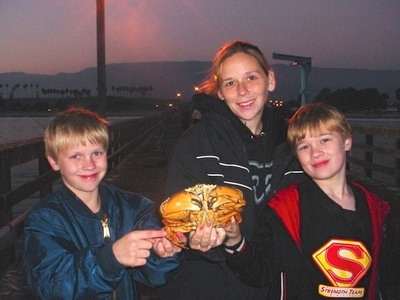
A Goleta Pier crab — Neil, Eric and Brandy Acker
*For most crabs wintertime is the time to go crabbing. As crabs grow they must molt or shed their hard shells. This typically happens during the warm summer months and during this time their body is full of water and the chemicals needed to harden their new shells; the result is soft and unappealing meat. Once the new shell hardens, the texture becomes firmer, and the meat is much better tasting. In addition, the deeper water species are really only common inshore during the winter months, November or December through March—with the exception of far-northern waters.
 * Be sure to check current Fish and Game regulations before you go “crabbing.” Minimum size restrictions, open waters, approved seasons, and legal bag limits will all be explained.
* Be sure to check current Fish and Game regulations before you go “crabbing.” Minimum size restrictions, open waters, approved seasons, and legal bag limits will all be explained.
••••••••• Some Odds and Ends ••••••••••
 California king crab ( Paralithodes californiensis)? — from the Goleta Pier
California king crab ( Paralithodes californiensis)? — from the Goleta Pier
Southern kelp crab aka globose kelp crab (Taliepus nutalli) from the San Clemente Pier (missing part of a leg)
 Graceful crab (Cancer gracilis) — note the white tips on the claws in contrast to the black tips on a yellow rock crab
Graceful crab (Cancer gracilis) — note the white tips on the claws in contrast to the black tips on a yellow rock crab
 Weird crab from the Seal Beach Pier — actually moss crab (Loxorhynchus crispatus)
Weird crab from the Seal Beach Pier — actually moss crab (Loxorhynchus crispatus)
I did not initially know what this creature was. Thus the label “weird crab.” But then I received a note from a friend who is a marine biologist and the crab was identified as a decorator crab Oregonia gracilis Dana, 1851, Graceful Decorator Crab
http://www.bily.com/pnwsc/web-content/Crustacean%20Identification.html
However, I then received a second note from marine biologist Gregory Jensen who said the “mystery crab is a juvenile Loxorhynchus, not Oregonia. Probably the moss crab, L. crispatus.” His views were seconded by another teacher of marine biology specializing in crabs, Nin Gan, so we are going to go with the identification as a juvenile Loxorhynchus crispatus. It shows once again how hard it can be to identify a species based just on pictures.
Mr. Jensen by the way is considered an expert on crabs and the author of books on the same.
http://www.molamarine.com/US%20order%20page.html
 Young spider crabs (sheep crabs) — Goleta Pier
Young spider crabs (sheep crabs) — Goleta Pier
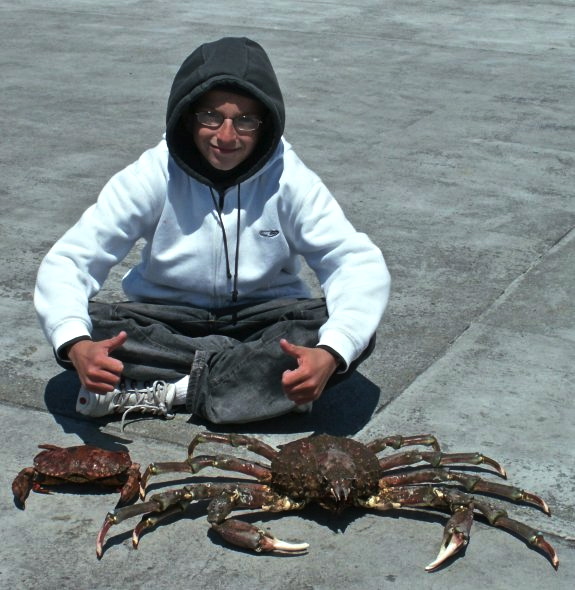 A crab combo-pack taken by Daniel at the Redondo Sportfishing Pier
A crab combo-pack taken by Daniel at the Redondo Sportfishing Pier
 Decorator crab from Stearns Wharf in Santa Barbara
Decorator crab from Stearns Wharf in Santa Barbara
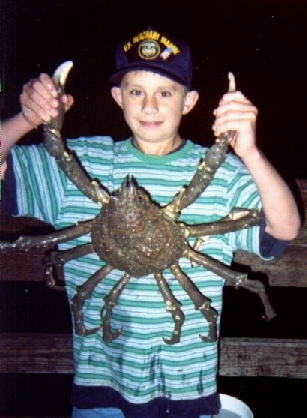 A sheep crab (spider crab) taken from the Ventura Pier in 2012
A sheep crab (spider crab) taken from the Ventura Pier in 2012
 A mix of crabs at the Spud Point Marina Pier
A mix of crabs at the Spud Point Marina Pier
 A trio of crabs from the Spud Point Marina Pier
A trio of crabs from the Spud Point Marina Pier
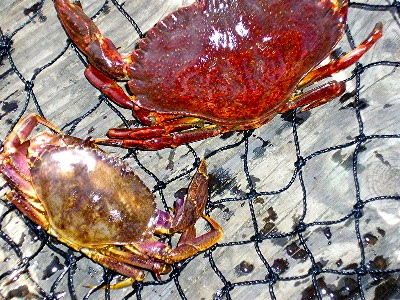 Red crab (top) and slender crab (bottom) from the Pillar Point Pier
Red crab (top) and slender crab (bottom) from the Pillar Point Pier
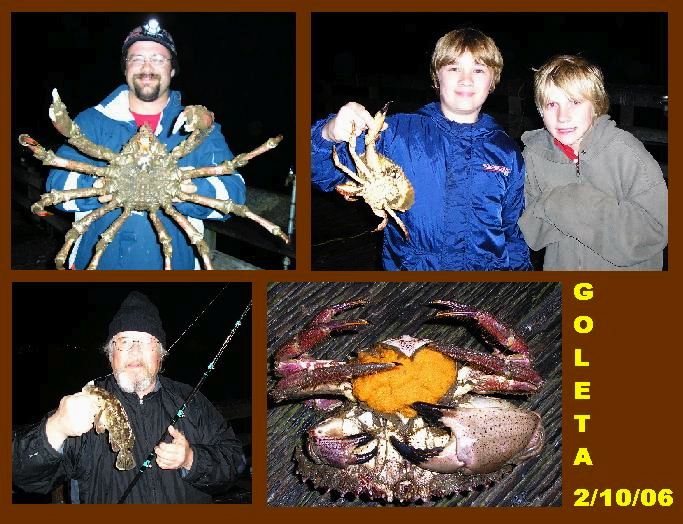 A nice night-time outing (and variety) at the Goleta Pier with dompfa ben
A nice night-time outing (and variety) at the Goleta Pier with dompfa ben
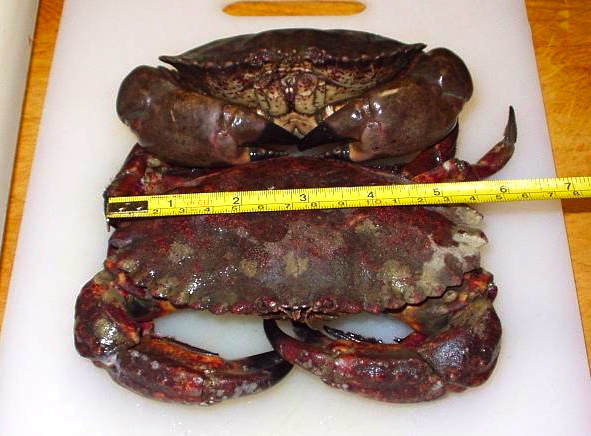 Rock crab on top, red crab on the bottom — caught by transbaby
Rock crab on top, red crab on the bottom — caught by transbaby
Crab taken at the Elephant Rock Pier by gdawg
 A crab caught by the dompfa bros at San Clemente Pier
A crab caught by the dompfa bros at San Clemente Pier
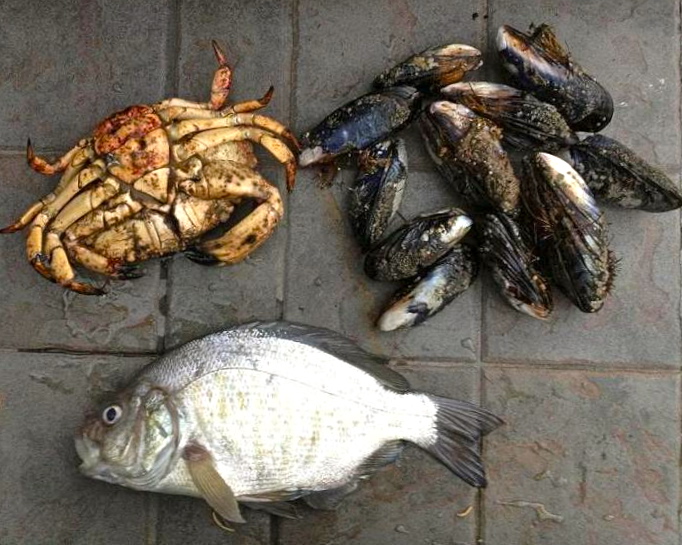 The start of a bouillabaisse—perch, crab and mussels (catch made by catchinkelp).
The start of a bouillabaisse—perch, crab and mussels (catch made by catchinkelp).
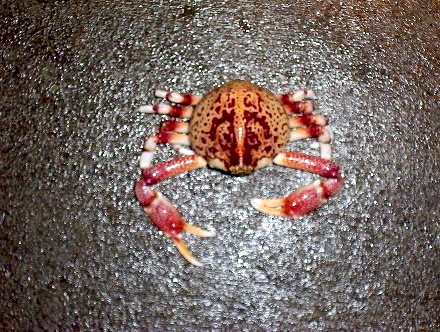 Globe Crab from the Goleta Pier
Globe Crab from the Goleta Pier
 Looks like we’re going to have some crabs for dinner! Elephant Rock Pier
Looks like we’re going to have some crabs for dinner! Elephant Rock Pier
Dinner from the Fort Baker Pier
 Crabs from the Pillar Point Pier
Crabs from the Pillar Point Pier
 Sea Star eating a crab — Stearns Wharf, Santa Barbara
Sea Star eating a crab — Stearns Wharf, Santa Barbara
____________________________________________________
Many thanks to Ed Roberts and Paul Gregory (retired) of the California Department of Fish and Wildlife, Gregory Jensen of the University of Washington, and Nin Gan of Saddleback College for their invaluable help with the identification of these crabs. Good thing because I am a fisherman, not a crabber.
I also want to give a big thanks to the Oregon Department of Fish and Wildlife for their help and willingness to share information and resources including the “Crab ID” pictures.
___________________________________________________________________________________
Catching Dungeness Crabs at Brookings Harbor, Oregon, just four miles from the California state line.
#1 — Using a net
 A lot of Dungeness but all too small.
A lot of Dungeness but all too small.
#2 — Using a rod and reel with a crab trap
_____________________________A Question on Claws_____________________________
February 19, 2017, To: Ken Jones
Can you explain the discrepancy between harvesting claws only in South Carolina and Florida and the fact that the practice of taking a claw and returning the crab to its habitat is illegal in California?
Thanks, Terry J, Soquel, CA
Terry,
Here’s the official response that was given by the California Fish and Wildlife Department to a similar question a few years back.
Ken
|
FOR IMMEDIATE RELEASE – February 20, 2014 Question: Our fishing club is planning a fishing trip for local crab out of the Santa Monica Bay area. Some people in the group insist we should only keep one claw from each crab so they can be put back to grow another claw and still live. I know with lobsters we are instructed to leave them whole until they are ready for consumption to allow the wildlife officer to verify it’s a legal catch. Is it legal to keep only one claw or do we need the entire crab to allow the wildlife officer to verify? (Jerry E.) Answer: You are required to take the whole legal-sized crab to prove your crab is of legal size. Possessing just claws would be a violation because the size of the crabs they came from cannot be determined (Fish and Game Code, Section 5508). Crabs also carry a lot of meat in the body. Crab season for all crabs of the genus Cancer (except Dungeness crabs) is open all year. The size limit in Southern California is four inches and the part of the crab that we measure is the main body shell (edge of shell to edge of shell at the widest part). While crabs may be able to regenerate lost claws under good conditions, crabs with only one claw have a far tougher time fending off predators than if they had both claws for protection. Predators will go after any weakened animal, so just removing a claw may be considered a waste of fish – also a state violation. |











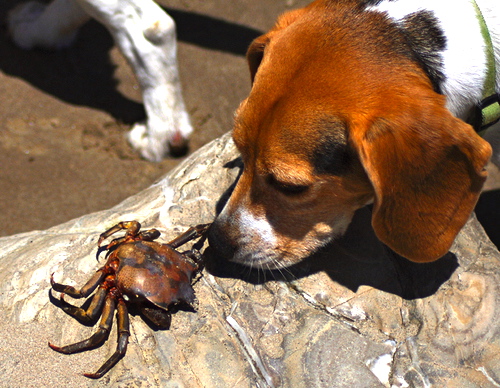


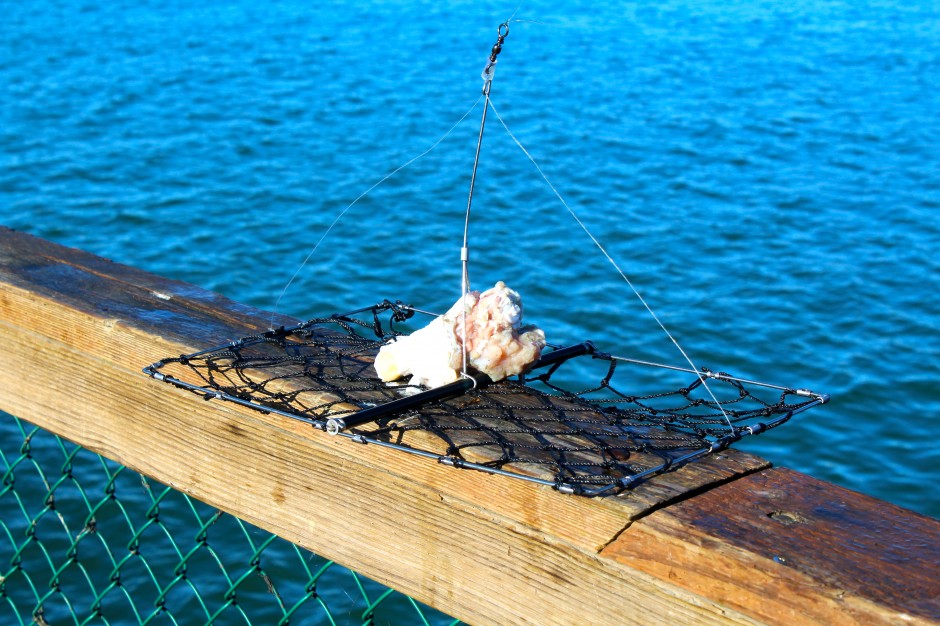













great information, thankyou
Thanks, Ken! Time to go hooping!!
Hi Ken -
Trying to track down information on a crab I just bought at the farmer’s market in San Diego. The vendor calls this a racer crab – but I can not find any information on a racer crab. See blog post link here (has a picture): http://backyardgourmandsandiego.blogspot.com/2015/05/racer-crabs-first-taste.html
Any chance you know what this crab is really called?
Adam
I wish I could tell you what this is but I am not sure. I have sent the info on to a friend in the CA DF&W who might know the species. Thanks for the note, Ken
Adam, Retired marine biologist Paul Gregory replied to your question — The racer crab is: Platymera gaudichaudii
http://mexfish.com/fish/pacoboxcr/pacoboxcr.htm
I plan parties and excursions at a luxury senior retirement community in Palo Alto. We are planning a crab event here at our community mid October celebrating everything crabs!
Do you or do you know of anyone who could have a crab tasting station and/or an instructional booth for our residents to learn and enjoy crabs?
Any information you could provide would be greatly appreciated.
Thank you,
Siobhan
I’m sorry but I really don’t know anyone in that area. Good luck on your event. Ken
Your weird crab is a decorator crab:
Oregonia gracilis Dana, 1851
Graceful Decorator Crab
http://www.bily.com/pnwsc/web-content/Crustacean%20Identification.html
The racer crab is:
Platymera gaudichaudii
http://mexfish.com/fish/pacoboxcr/pacoboxcr.htm
Thanks Paul, I appreciate the help. For those who do not know, Paul is a retired marine biologist who worked for the California Department of Fish and Game.
The three photos labelled as ‘antennarium’ are all Cancer productus. Pacific or brown rock crabs have much more distinct red freckles on the underside, and the teeth between the eyes do not project forward like they do in red rock crabs. The teeth along the edge of the carapace are also very different in shape.
The mystery crab is a juvenile Loxorhynchus, not Oregonia. Probably the moss crab, L. crispatus.
Hi Ken, I’m an instructor at Saddleback College with a marine biology background specializing in crabs! I noticed some of the pictures were not matched with the right species. I would like to offer my feedback!
All three of the rock crab (Romaleon antennarius) pictures are actually of the red rock crab (Cancer productus).
In the sheep crab section, the little boy, holding a small crab “A small sheep crab (spider crab) from Stearns Wharf in Santa Barbara) is a decorator crab.
I don’t know the max size limit of the kelp crab (Pugettia producta), but I assure you it does not reach a 9.6 inch carapace width.
The picture “Kelp crab from the San Clemente Pier (missing part of a leg)” is not the Northern kelp crab (Pugettia producta), it’s a Southern kelp crab (Taliepus nutalli).
The picture “Red crab and rock crab from the Pillar Point Pier” is actually a red rock crab (or red crab if you’d rather) top right, and a slender crab (Metacarcinus gracilis) bottom left.
The picture “Red crab on top, rock crab on the bottom – from transbaby” <– maybe you meant 'transbay'? But anyway, it's reversed, the rock crab is on top and red crab is on the bottom.
Also with the "weird crab" I agree with Jensen on the Loxorynchus sp.
Hope this helps!
Thanks and you’ll see that I’ve made considerable changes from the original post. I have two new “Crab” advisors and look forward to any advice you may have in the future.
Do you recommend any piers in particular for catching crab in SoCal?
And, am I correct in understanding that crab snares are illegal in SoCal?
What about something like this? https://slickdeals.net/f/11370499-south-bend-2-ring-crab-net-for-2-20-at-walmart
I think the best piers in SoCal might be Santa Monica and Stearns Wharf (Santa Barbara) but others can also yield a few crabs. As for crab snares, no they are illegal due to different regulations (caused in part because lobsters are found in SoCal and snares would be an illegal method to take them). A hoop net is allowed to take crabs and lobsters.
While walking at Carpinteria beach I found a dead crab and took a picture of it. I’ve never seen one like this on the beach and wondering if I sent you a picture, you could tell me what kind of crab. There is a lot of allege on it, but it has pink and a blue purplish color on it claws and body. thank you,
Sorry, but I don’t see any picture. Ken